Analyzing Australia's Macroeconomic Condition using AE Model Approach
VerifiedAdded on 2023/06/14
|13
|2403
|346
Report
AI Summary
This report provides a comprehensive analysis of Australia's macroeconomic condition using the aggregate expenditure model, examining components such as consumption, investment, government expenditure, and net exports. It details the trends in these components over the past decade and ...
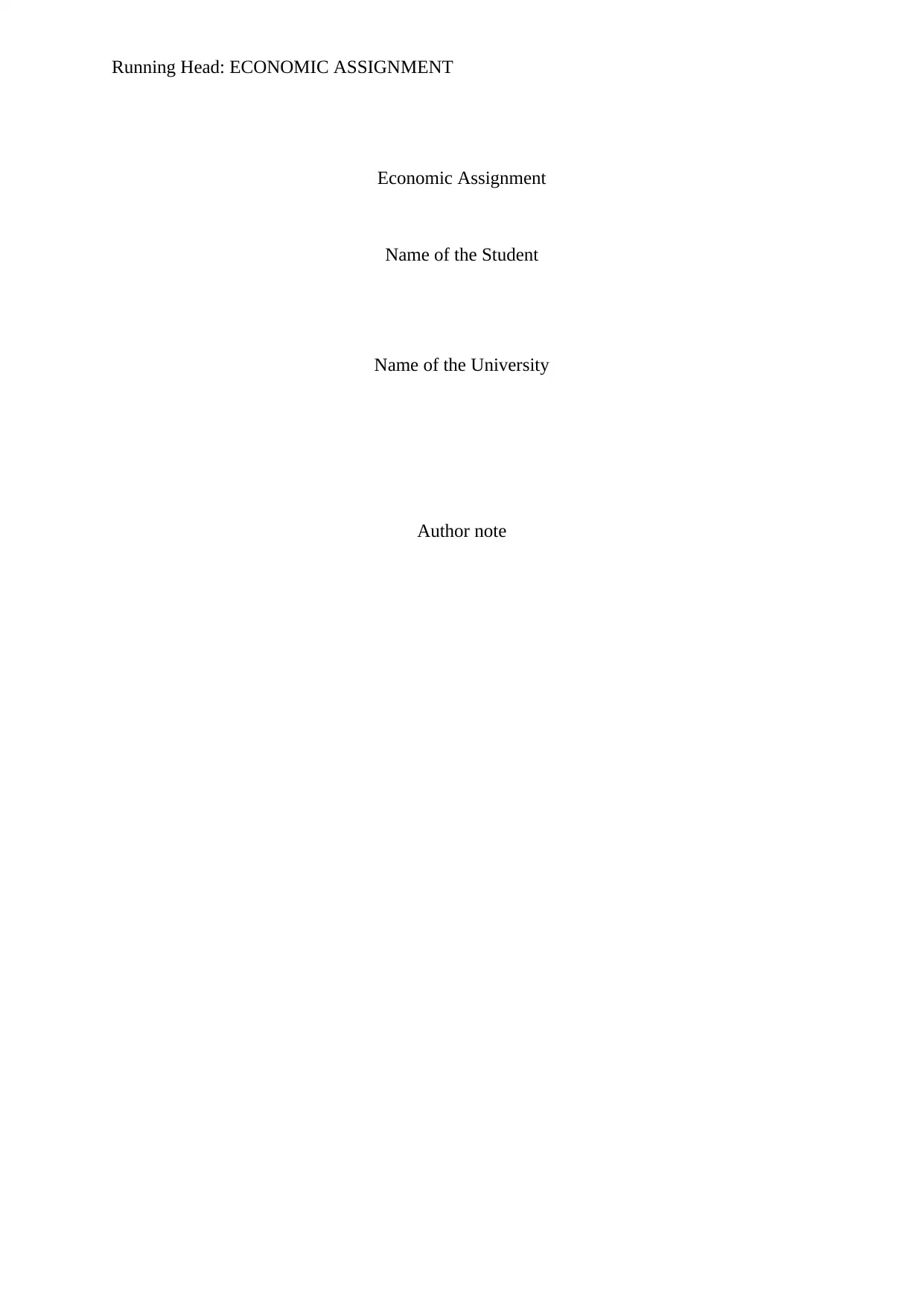
Running Head: ECONOMIC ASSIGNMENT
Economic Assignment
Name of the Student
Name of the University
Author note
Economic Assignment
Name of the Student
Name of the University
Author note
Paraphrase This Document
Need a fresh take? Get an instant paraphrase of this document with our AI Paraphraser
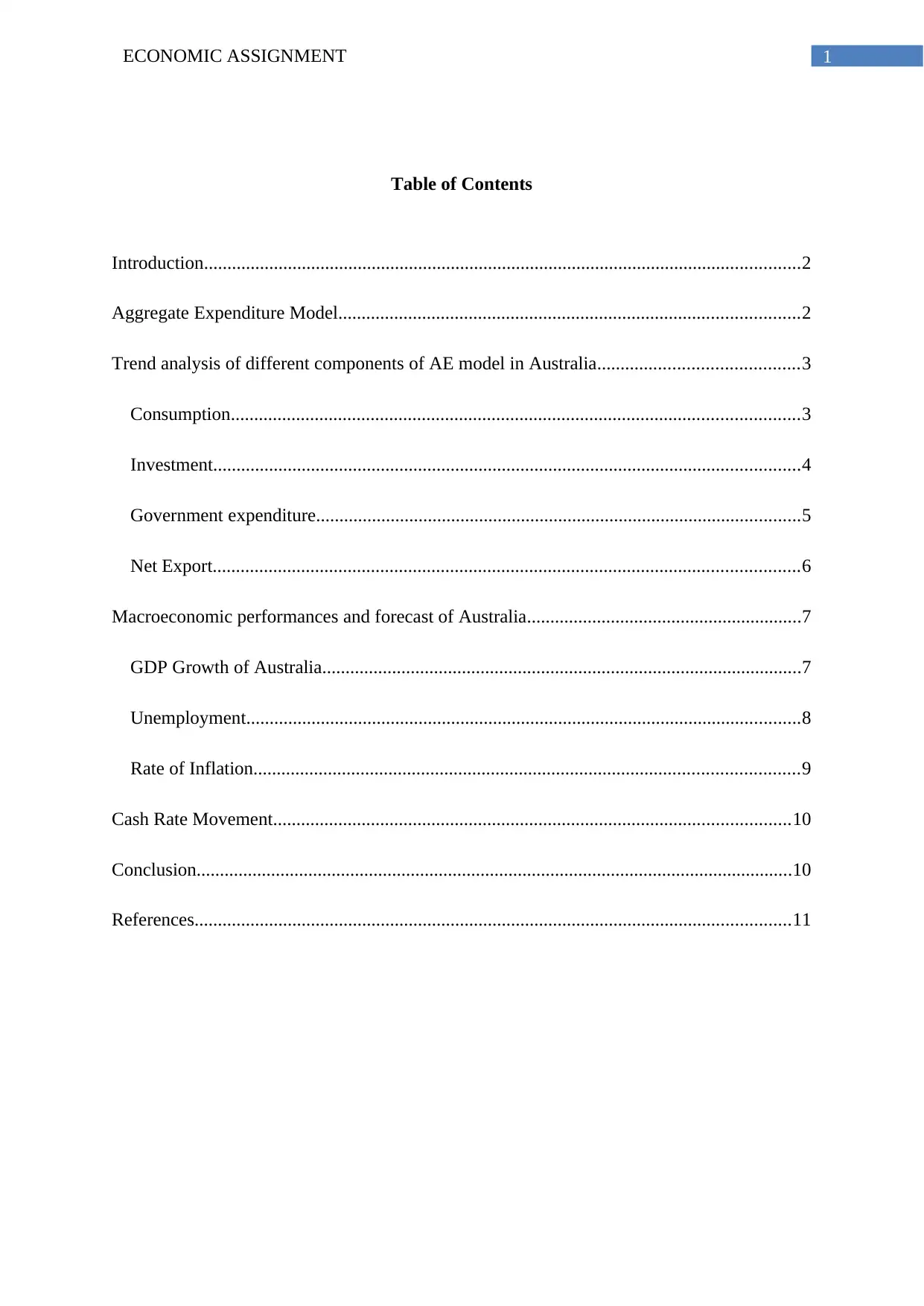
1ECONOMIC ASSIGNMENT
Table of Contents
Introduction................................................................................................................................2
Aggregate Expenditure Model...................................................................................................2
Trend analysis of different components of AE model in Australia...........................................3
Consumption..........................................................................................................................3
Investment..............................................................................................................................4
Government expenditure........................................................................................................5
Net Export..............................................................................................................................6
Macroeconomic performances and forecast of Australia...........................................................7
GDP Growth of Australia.......................................................................................................7
Unemployment.......................................................................................................................8
Rate of Inflation.....................................................................................................................9
Cash Rate Movement...............................................................................................................10
Conclusion................................................................................................................................10
References................................................................................................................................11
Table of Contents
Introduction................................................................................................................................2
Aggregate Expenditure Model...................................................................................................2
Trend analysis of different components of AE model in Australia...........................................3
Consumption..........................................................................................................................3
Investment..............................................................................................................................4
Government expenditure........................................................................................................5
Net Export..............................................................................................................................6
Macroeconomic performances and forecast of Australia...........................................................7
GDP Growth of Australia.......................................................................................................7
Unemployment.......................................................................................................................8
Rate of Inflation.....................................................................................................................9
Cash Rate Movement...............................................................................................................10
Conclusion................................................................................................................................10
References................................................................................................................................11
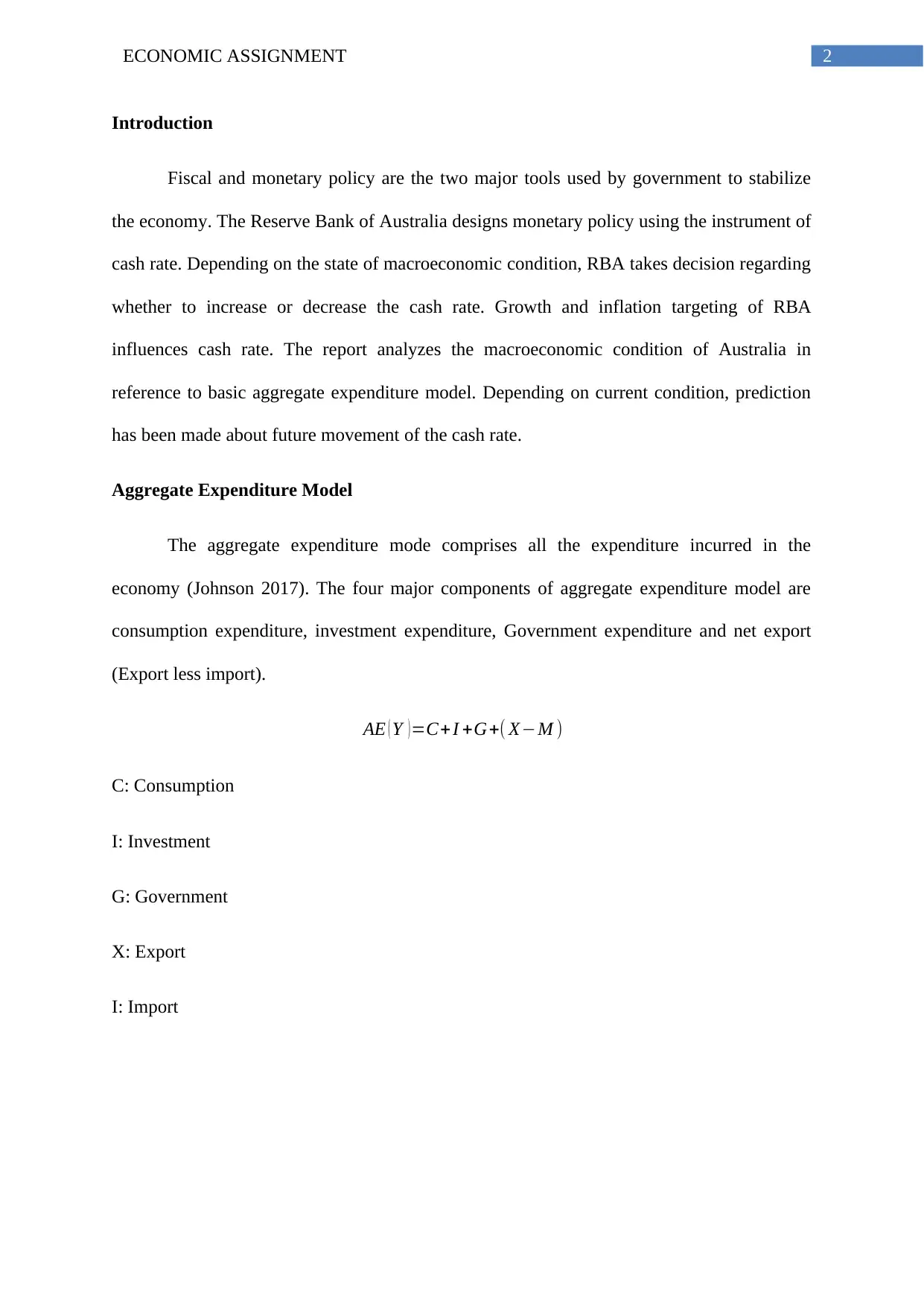
2ECONOMIC ASSIGNMENT
Introduction
Fiscal and monetary policy are the two major tools used by government to stabilize
the economy. The Reserve Bank of Australia designs monetary policy using the instrument of
cash rate. Depending on the state of macroeconomic condition, RBA takes decision regarding
whether to increase or decrease the cash rate. Growth and inflation targeting of RBA
influences cash rate. The report analyzes the macroeconomic condition of Australia in
reference to basic aggregate expenditure model. Depending on current condition, prediction
has been made about future movement of the cash rate.
Aggregate Expenditure Model
The aggregate expenditure mode comprises all the expenditure incurred in the
economy (Johnson 2017). The four major components of aggregate expenditure model are
consumption expenditure, investment expenditure, Government expenditure and net export
(Export less import).
AE ( Y ) =C+ I +G+( X−M )
C: Consumption
I: Investment
G: Government
X: Export
I: Import
Introduction
Fiscal and monetary policy are the two major tools used by government to stabilize
the economy. The Reserve Bank of Australia designs monetary policy using the instrument of
cash rate. Depending on the state of macroeconomic condition, RBA takes decision regarding
whether to increase or decrease the cash rate. Growth and inflation targeting of RBA
influences cash rate. The report analyzes the macroeconomic condition of Australia in
reference to basic aggregate expenditure model. Depending on current condition, prediction
has been made about future movement of the cash rate.
Aggregate Expenditure Model
The aggregate expenditure mode comprises all the expenditure incurred in the
economy (Johnson 2017). The four major components of aggregate expenditure model are
consumption expenditure, investment expenditure, Government expenditure and net export
(Export less import).
AE ( Y ) =C+ I +G+( X−M )
C: Consumption
I: Investment
G: Government
X: Export
I: Import
⊘ This is a preview!⊘
Do you want full access?
Subscribe today to unlock all pages.

Trusted by 1+ million students worldwide
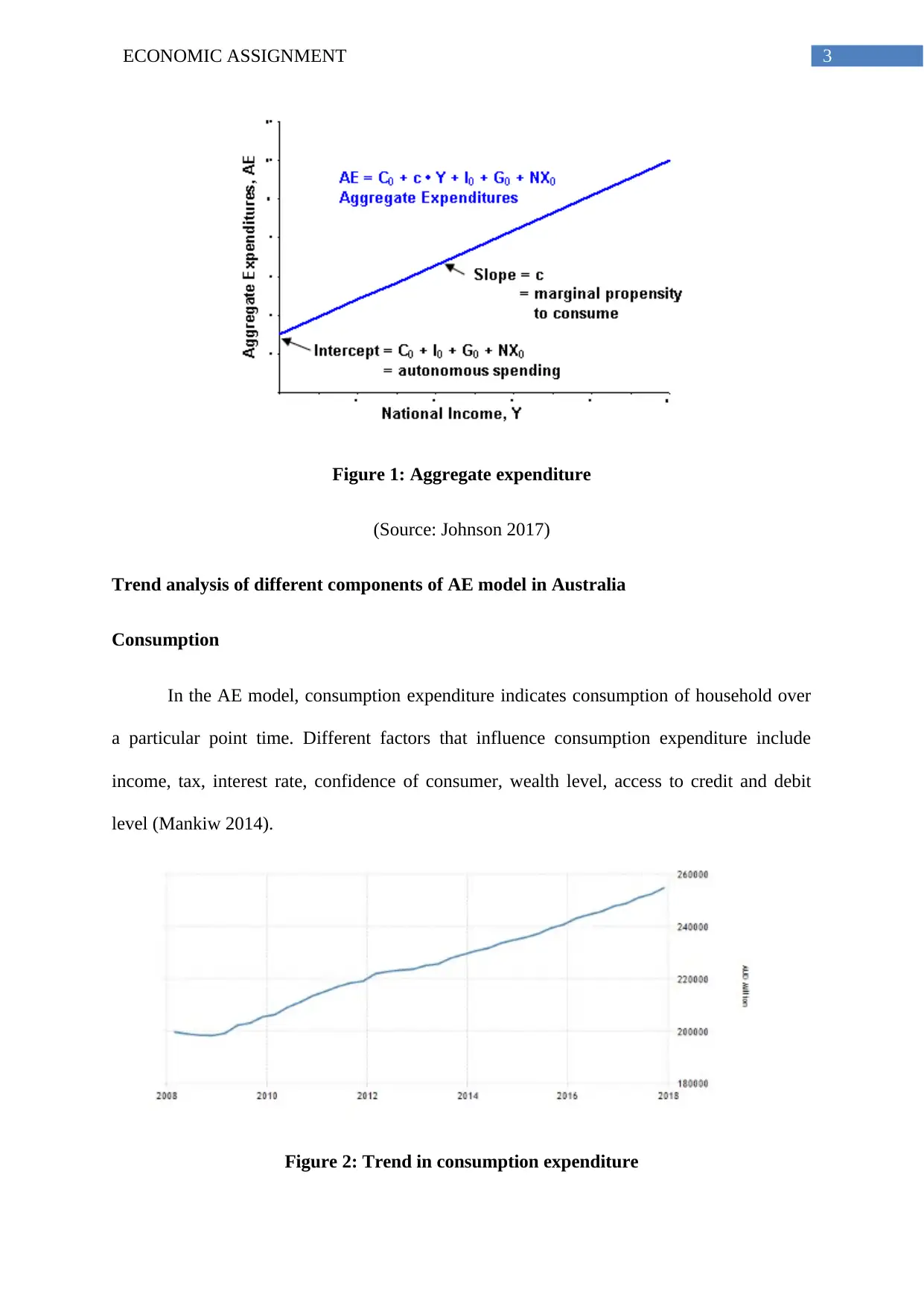
3ECONOMIC ASSIGNMENT
Figure 1: Aggregate expenditure
(Source: Johnson 2017)
Trend analysis of different components of AE model in Australia
Consumption
In the AE model, consumption expenditure indicates consumption of household over
a particular point time. Different factors that influence consumption expenditure include
income, tax, interest rate, confidence of consumer, wealth level, access to credit and debit
level (Mankiw 2014).
Figure 2: Trend in consumption expenditure
Figure 1: Aggregate expenditure
(Source: Johnson 2017)
Trend analysis of different components of AE model in Australia
Consumption
In the AE model, consumption expenditure indicates consumption of household over
a particular point time. Different factors that influence consumption expenditure include
income, tax, interest rate, confidence of consumer, wealth level, access to credit and debit
level (Mankiw 2014).
Figure 2: Trend in consumption expenditure
Paraphrase This Document
Need a fresh take? Get an instant paraphrase of this document with our AI Paraphraser
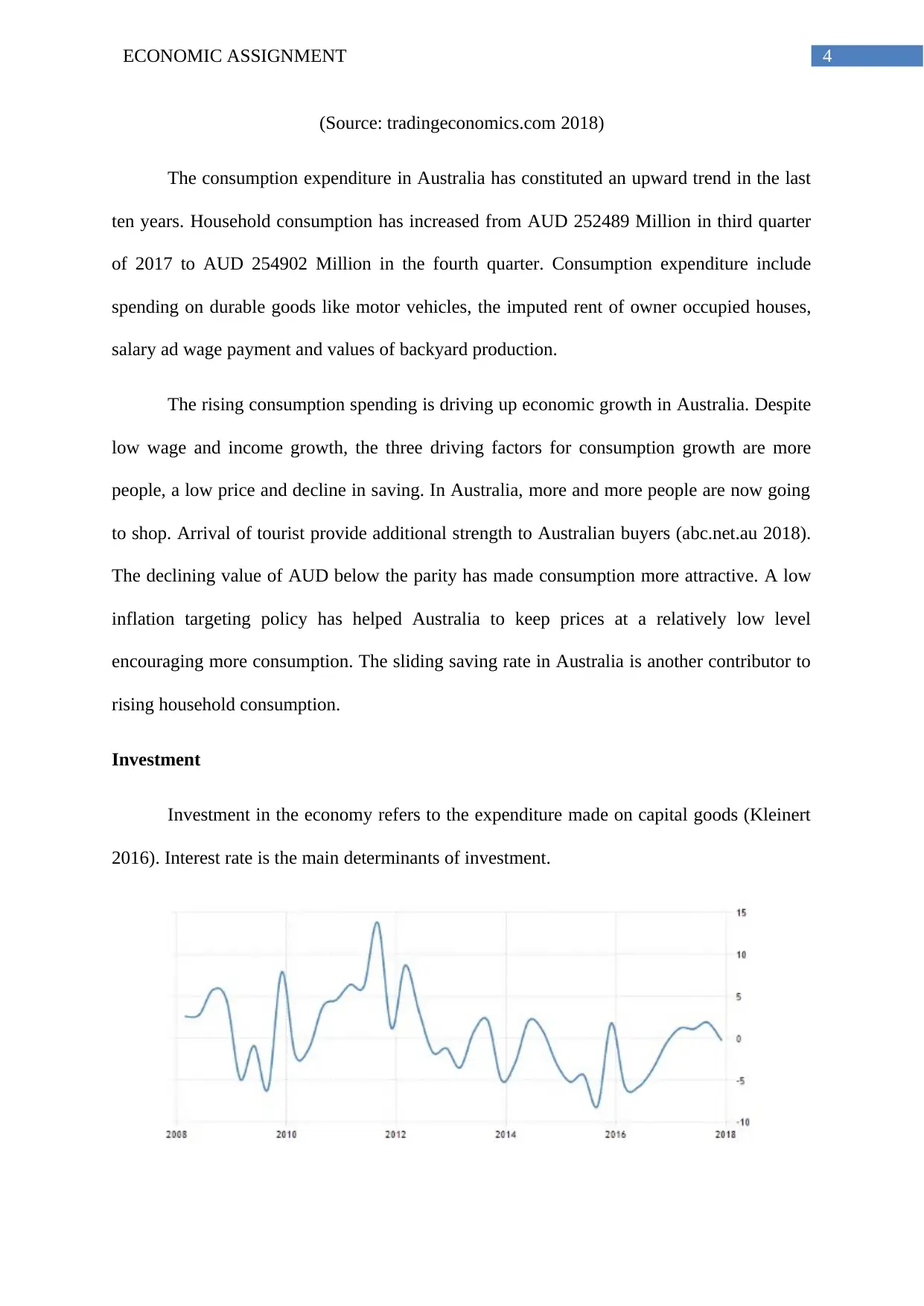
4ECONOMIC ASSIGNMENT
(Source: tradingeconomics.com 2018)
The consumption expenditure in Australia has constituted an upward trend in the last
ten years. Household consumption has increased from AUD 252489 Million in third quarter
of 2017 to AUD 254902 Million in the fourth quarter. Consumption expenditure include
spending on durable goods like motor vehicles, the imputed rent of owner occupied houses,
salary ad wage payment and values of backyard production.
The rising consumption spending is driving up economic growth in Australia. Despite
low wage and income growth, the three driving factors for consumption growth are more
people, a low price and decline in saving. In Australia, more and more people are now going
to shop. Arrival of tourist provide additional strength to Australian buyers (abc.net.au 2018).
The declining value of AUD below the parity has made consumption more attractive. A low
inflation targeting policy has helped Australia to keep prices at a relatively low level
encouraging more consumption. The sliding saving rate in Australia is another contributor to
rising household consumption.
Investment
Investment in the economy refers to the expenditure made on capital goods (Kleinert
2016). Interest rate is the main determinants of investment.
(Source: tradingeconomics.com 2018)
The consumption expenditure in Australia has constituted an upward trend in the last
ten years. Household consumption has increased from AUD 252489 Million in third quarter
of 2017 to AUD 254902 Million in the fourth quarter. Consumption expenditure include
spending on durable goods like motor vehicles, the imputed rent of owner occupied houses,
salary ad wage payment and values of backyard production.
The rising consumption spending is driving up economic growth in Australia. Despite
low wage and income growth, the three driving factors for consumption growth are more
people, a low price and decline in saving. In Australia, more and more people are now going
to shop. Arrival of tourist provide additional strength to Australian buyers (abc.net.au 2018).
The declining value of AUD below the parity has made consumption more attractive. A low
inflation targeting policy has helped Australia to keep prices at a relatively low level
encouraging more consumption. The sliding saving rate in Australia is another contributor to
rising household consumption.
Investment
Investment in the economy refers to the expenditure made on capital goods (Kleinert
2016). Interest rate is the main determinants of investment.
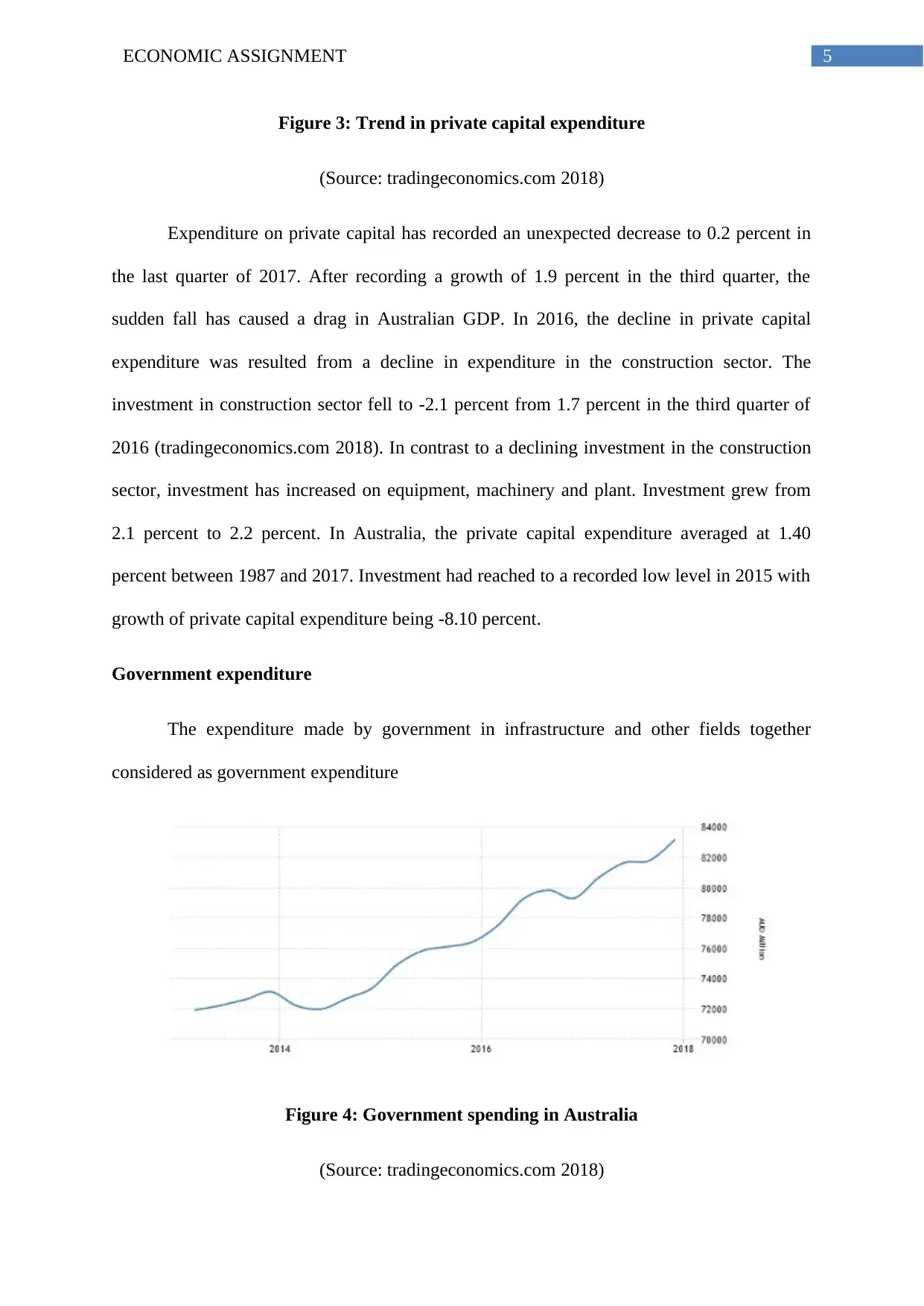
5ECONOMIC ASSIGNMENT
Figure 3: Trend in private capital expenditure
(Source: tradingeconomics.com 2018)
Expenditure on private capital has recorded an unexpected decrease to 0.2 percent in
the last quarter of 2017. After recording a growth of 1.9 percent in the third quarter, the
sudden fall has caused a drag in Australian GDP. In 2016, the decline in private capital
expenditure was resulted from a decline in expenditure in the construction sector. The
investment in construction sector fell to -2.1 percent from 1.7 percent in the third quarter of
2016 (tradingeconomics.com 2018). In contrast to a declining investment in the construction
sector, investment has increased on equipment, machinery and plant. Investment grew from
2.1 percent to 2.2 percent. In Australia, the private capital expenditure averaged at 1.40
percent between 1987 and 2017. Investment had reached to a recorded low level in 2015 with
growth of private capital expenditure being -8.10 percent.
Government expenditure
The expenditure made by government in infrastructure and other fields together
considered as government expenditure
Figure 4: Government spending in Australia
(Source: tradingeconomics.com 2018)
Figure 3: Trend in private capital expenditure
(Source: tradingeconomics.com 2018)
Expenditure on private capital has recorded an unexpected decrease to 0.2 percent in
the last quarter of 2017. After recording a growth of 1.9 percent in the third quarter, the
sudden fall has caused a drag in Australian GDP. In 2016, the decline in private capital
expenditure was resulted from a decline in expenditure in the construction sector. The
investment in construction sector fell to -2.1 percent from 1.7 percent in the third quarter of
2016 (tradingeconomics.com 2018). In contrast to a declining investment in the construction
sector, investment has increased on equipment, machinery and plant. Investment grew from
2.1 percent to 2.2 percent. In Australia, the private capital expenditure averaged at 1.40
percent between 1987 and 2017. Investment had reached to a recorded low level in 2015 with
growth of private capital expenditure being -8.10 percent.
Government expenditure
The expenditure made by government in infrastructure and other fields together
considered as government expenditure
Figure 4: Government spending in Australia
(Source: tradingeconomics.com 2018)
⊘ This is a preview!⊘
Do you want full access?
Subscribe today to unlock all pages.

Trusted by 1+ million students worldwide
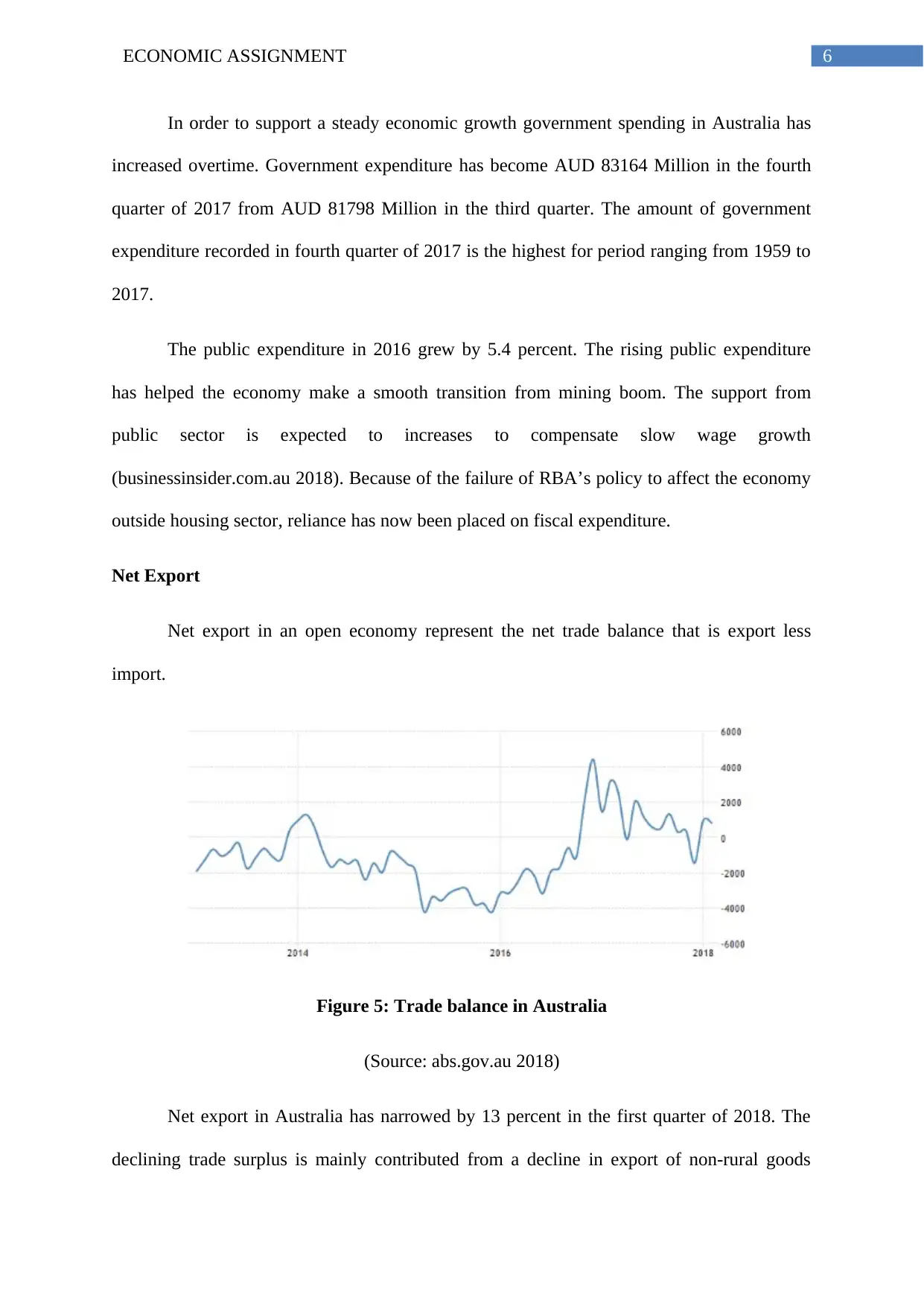
6ECONOMIC ASSIGNMENT
In order to support a steady economic growth government spending in Australia has
increased overtime. Government expenditure has become AUD 83164 Million in the fourth
quarter of 2017 from AUD 81798 Million in the third quarter. The amount of government
expenditure recorded in fourth quarter of 2017 is the highest for period ranging from 1959 to
2017.
The public expenditure in 2016 grew by 5.4 percent. The rising public expenditure
has helped the economy make a smooth transition from mining boom. The support from
public sector is expected to increases to compensate slow wage growth
(businessinsider.com.au 2018). Because of the failure of RBA’s policy to affect the economy
outside housing sector, reliance has now been placed on fiscal expenditure.
Net Export
Net export in an open economy represent the net trade balance that is export less
import.
Figure 5: Trade balance in Australia
(Source: abs.gov.au 2018)
Net export in Australia has narrowed by 13 percent in the first quarter of 2018. The
declining trade surplus is mainly contributed from a decline in export of non-rural goods
In order to support a steady economic growth government spending in Australia has
increased overtime. Government expenditure has become AUD 83164 Million in the fourth
quarter of 2017 from AUD 81798 Million in the third quarter. The amount of government
expenditure recorded in fourth quarter of 2017 is the highest for period ranging from 1959 to
2017.
The public expenditure in 2016 grew by 5.4 percent. The rising public expenditure
has helped the economy make a smooth transition from mining boom. The support from
public sector is expected to increases to compensate slow wage growth
(businessinsider.com.au 2018). Because of the failure of RBA’s policy to affect the economy
outside housing sector, reliance has now been placed on fiscal expenditure.
Net Export
Net export in an open economy represent the net trade balance that is export less
import.
Figure 5: Trade balance in Australia
(Source: abs.gov.au 2018)
Net export in Australia has narrowed by 13 percent in the first quarter of 2018. The
declining trade surplus is mainly contributed from a decline in export of non-rural goods
Paraphrase This Document
Need a fresh take? Get an instant paraphrase of this document with our AI Paraphraser
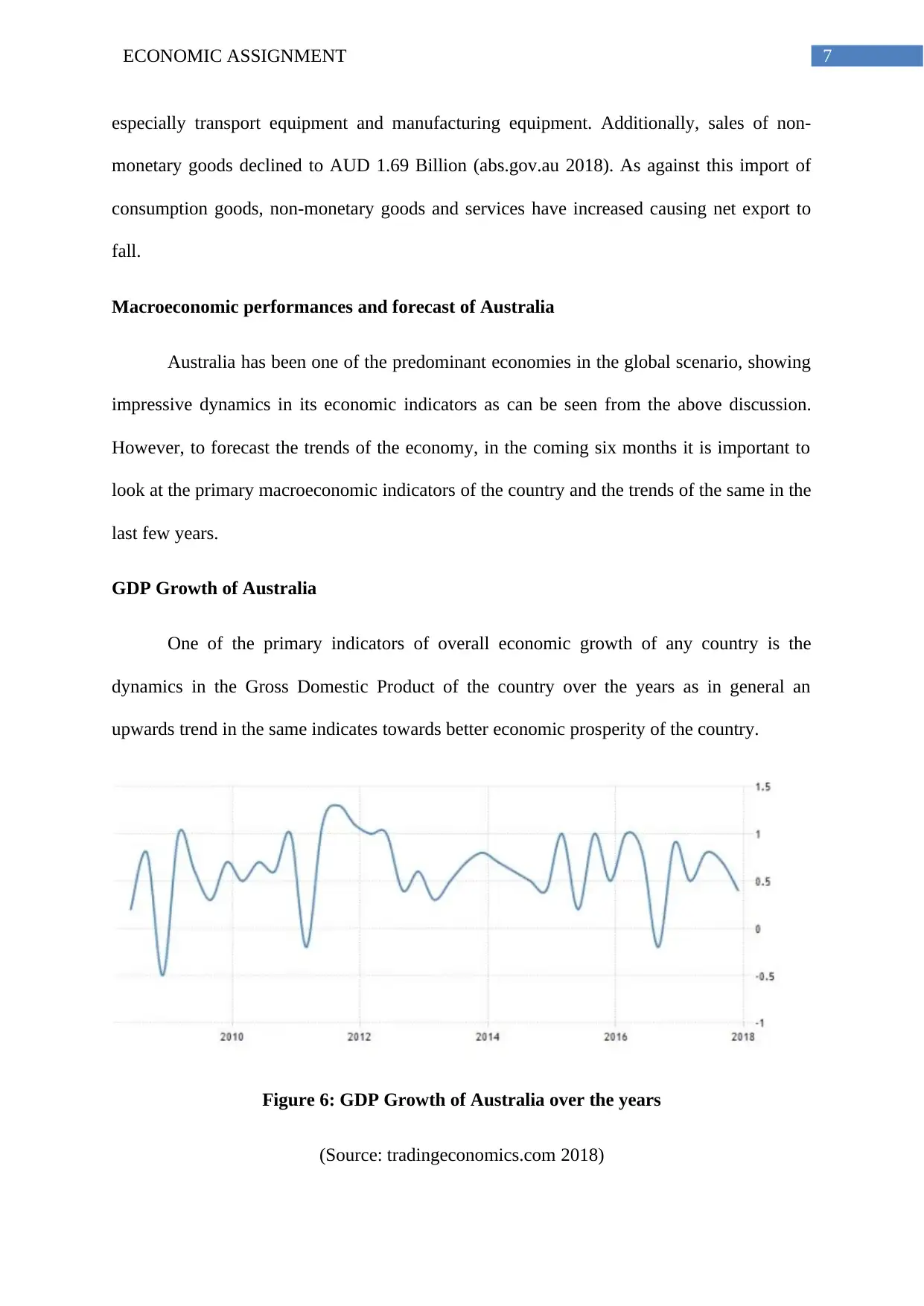
7ECONOMIC ASSIGNMENT
especially transport equipment and manufacturing equipment. Additionally, sales of non-
monetary goods declined to AUD 1.69 Billion (abs.gov.au 2018). As against this import of
consumption goods, non-monetary goods and services have increased causing net export to
fall.
Macroeconomic performances and forecast of Australia
Australia has been one of the predominant economies in the global scenario, showing
impressive dynamics in its economic indicators as can be seen from the above discussion.
However, to forecast the trends of the economy, in the coming six months it is important to
look at the primary macroeconomic indicators of the country and the trends of the same in the
last few years.
GDP Growth of Australia
One of the primary indicators of overall economic growth of any country is the
dynamics in the Gross Domestic Product of the country over the years as in general an
upwards trend in the same indicates towards better economic prosperity of the country.
Figure 6: GDP Growth of Australia over the years
(Source: tradingeconomics.com 2018)
especially transport equipment and manufacturing equipment. Additionally, sales of non-
monetary goods declined to AUD 1.69 Billion (abs.gov.au 2018). As against this import of
consumption goods, non-monetary goods and services have increased causing net export to
fall.
Macroeconomic performances and forecast of Australia
Australia has been one of the predominant economies in the global scenario, showing
impressive dynamics in its economic indicators as can be seen from the above discussion.
However, to forecast the trends of the economy, in the coming six months it is important to
look at the primary macroeconomic indicators of the country and the trends of the same in the
last few years.
GDP Growth of Australia
One of the primary indicators of overall economic growth of any country is the
dynamics in the Gross Domestic Product of the country over the years as in general an
upwards trend in the same indicates towards better economic prosperity of the country.
Figure 6: GDP Growth of Australia over the years
(Source: tradingeconomics.com 2018)
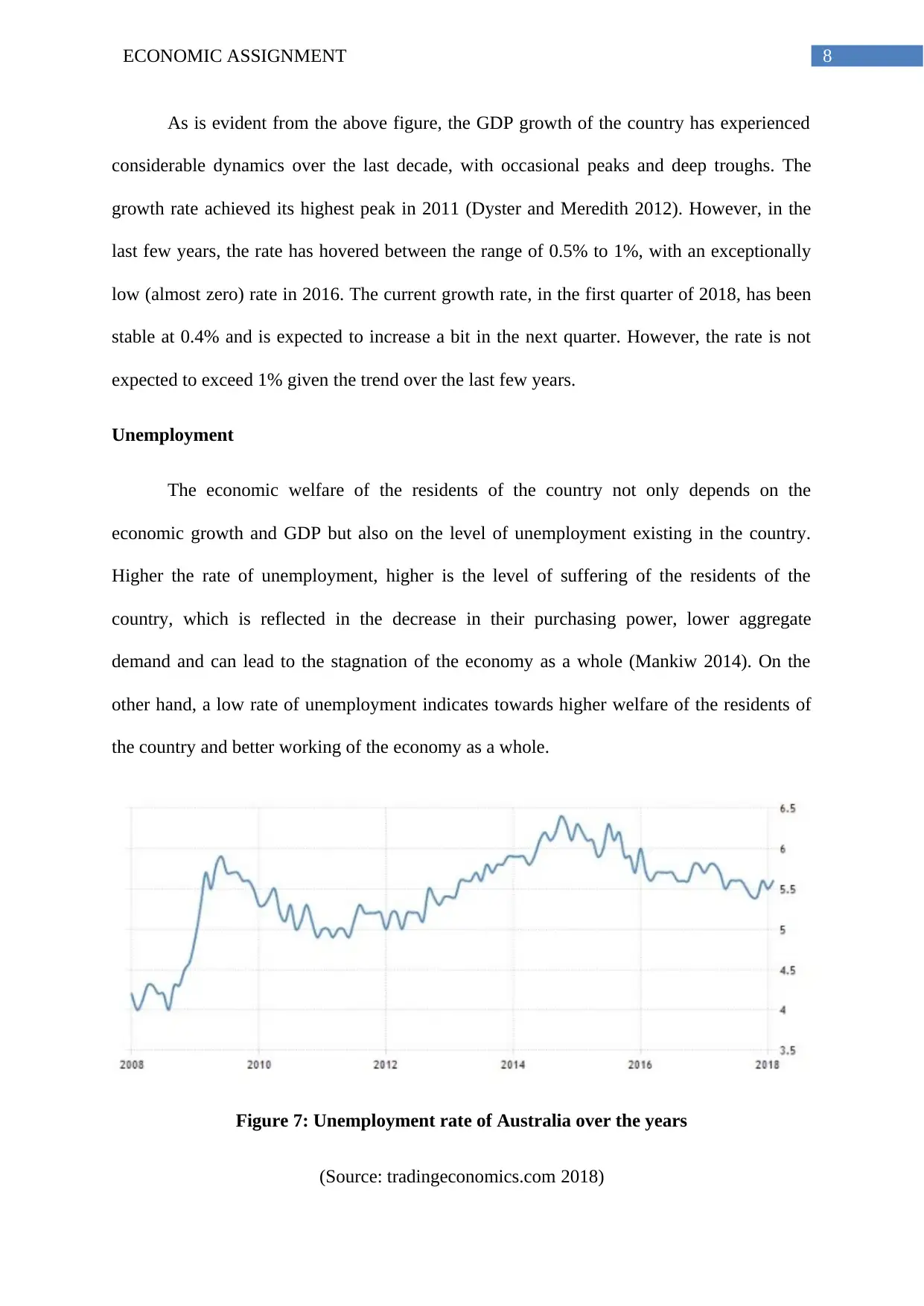
8ECONOMIC ASSIGNMENT
As is evident from the above figure, the GDP growth of the country has experienced
considerable dynamics over the last decade, with occasional peaks and deep troughs. The
growth rate achieved its highest peak in 2011 (Dyster and Meredith 2012). However, in the
last few years, the rate has hovered between the range of 0.5% to 1%, with an exceptionally
low (almost zero) rate in 2016. The current growth rate, in the first quarter of 2018, has been
stable at 0.4% and is expected to increase a bit in the next quarter. However, the rate is not
expected to exceed 1% given the trend over the last few years.
Unemployment
The economic welfare of the residents of the country not only depends on the
economic growth and GDP but also on the level of unemployment existing in the country.
Higher the rate of unemployment, higher is the level of suffering of the residents of the
country, which is reflected in the decrease in their purchasing power, lower aggregate
demand and can lead to the stagnation of the economy as a whole (Mankiw 2014). On the
other hand, a low rate of unemployment indicates towards higher welfare of the residents of
the country and better working of the economy as a whole.
Figure 7: Unemployment rate of Australia over the years
(Source: tradingeconomics.com 2018)
As is evident from the above figure, the GDP growth of the country has experienced
considerable dynamics over the last decade, with occasional peaks and deep troughs. The
growth rate achieved its highest peak in 2011 (Dyster and Meredith 2012). However, in the
last few years, the rate has hovered between the range of 0.5% to 1%, with an exceptionally
low (almost zero) rate in 2016. The current growth rate, in the first quarter of 2018, has been
stable at 0.4% and is expected to increase a bit in the next quarter. However, the rate is not
expected to exceed 1% given the trend over the last few years.
Unemployment
The economic welfare of the residents of the country not only depends on the
economic growth and GDP but also on the level of unemployment existing in the country.
Higher the rate of unemployment, higher is the level of suffering of the residents of the
country, which is reflected in the decrease in their purchasing power, lower aggregate
demand and can lead to the stagnation of the economy as a whole (Mankiw 2014). On the
other hand, a low rate of unemployment indicates towards higher welfare of the residents of
the country and better working of the economy as a whole.
Figure 7: Unemployment rate of Australia over the years
(Source: tradingeconomics.com 2018)
⊘ This is a preview!⊘
Do you want full access?
Subscribe today to unlock all pages.

Trusted by 1+ million students worldwide
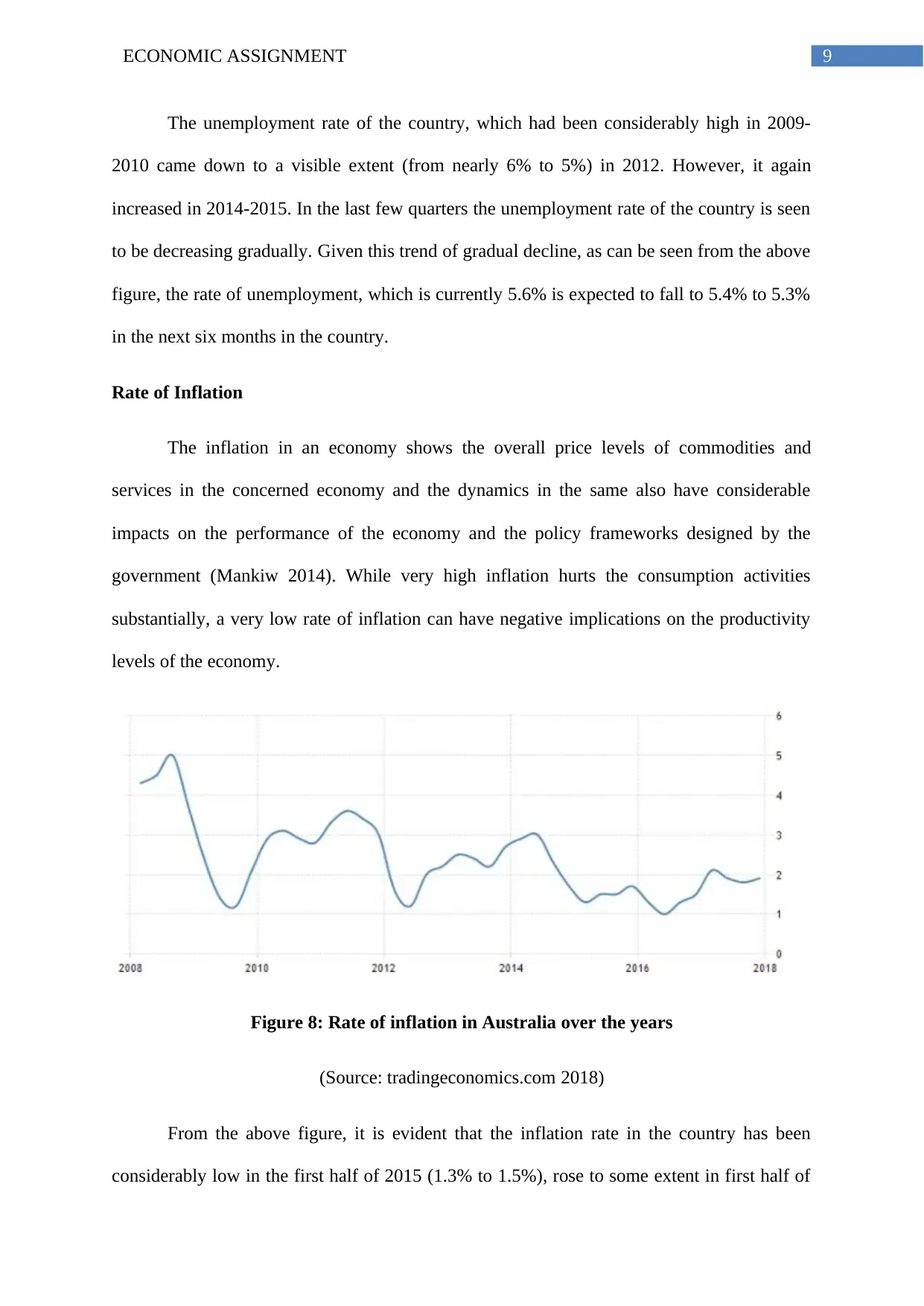
9ECONOMIC ASSIGNMENT
The unemployment rate of the country, which had been considerably high in 2009-
2010 came down to a visible extent (from nearly 6% to 5%) in 2012. However, it again
increased in 2014-2015. In the last few quarters the unemployment rate of the country is seen
to be decreasing gradually. Given this trend of gradual decline, as can be seen from the above
figure, the rate of unemployment, which is currently 5.6% is expected to fall to 5.4% to 5.3%
in the next six months in the country.
Rate of Inflation
The inflation in an economy shows the overall price levels of commodities and
services in the concerned economy and the dynamics in the same also have considerable
impacts on the performance of the economy and the policy frameworks designed by the
government (Mankiw 2014). While very high inflation hurts the consumption activities
substantially, a very low rate of inflation can have negative implications on the productivity
levels of the economy.
Figure 8: Rate of inflation in Australia over the years
(Source: tradingeconomics.com 2018)
From the above figure, it is evident that the inflation rate in the country has been
considerably low in the first half of 2015 (1.3% to 1.5%), rose to some extent in first half of
The unemployment rate of the country, which had been considerably high in 2009-
2010 came down to a visible extent (from nearly 6% to 5%) in 2012. However, it again
increased in 2014-2015. In the last few quarters the unemployment rate of the country is seen
to be decreasing gradually. Given this trend of gradual decline, as can be seen from the above
figure, the rate of unemployment, which is currently 5.6% is expected to fall to 5.4% to 5.3%
in the next six months in the country.
Rate of Inflation
The inflation in an economy shows the overall price levels of commodities and
services in the concerned economy and the dynamics in the same also have considerable
impacts on the performance of the economy and the policy frameworks designed by the
government (Mankiw 2014). While very high inflation hurts the consumption activities
substantially, a very low rate of inflation can have negative implications on the productivity
levels of the economy.
Figure 8: Rate of inflation in Australia over the years
(Source: tradingeconomics.com 2018)
From the above figure, it is evident that the inflation rate in the country has been
considerably low in the first half of 2015 (1.3% to 1.5%), rose to some extent in first half of
Paraphrase This Document
Need a fresh take? Get an instant paraphrase of this document with our AI Paraphraser

10ECONOMIC ASSIGNMENT
2016 (1.7%) and again came down considerably (1%) in second half of 2016. However, in
2017 the rate of inflation has been considerably high ranging from 2.1% in January, 2017 to
1.8% in July which again came up to 1.9% in January, 2018 (Dyster and Meredith 2012).
Given the current trends and the fall in the predicted fall in the unemployment rate in the
country (low unemployment leads to higher economic abundance and thereby increases
aggregate demand leading to an increase in the overall price levels), the inflation rate of the
country is expected to increase (2% to 2.1%) in the next six months.
Cash Rate Movement
Given the prediction of a low unemployment in the coming months, there is a
possibility of increase in the consumption expenditure in the country, which in turn is
expected to boost the economic growth of the same. However, there is also a threat of a
probable increase in the rate of inflation in the country. Keeping this into consideration, the
probable strategy which the monetary authority of the country can take for the coming six
months, is to keep the cash rate of the country at the same level (1.5%) which is prevailing in
the current period in the economy. Increasing the cash rate can dampen the consumption and
investment activities, thereby stagnating the probable economic growth of Australia, while
decreasing the same from 1.5% can add to the threats of greater inflation in the country
(Rba.gov.au 2018).
Conclusion
As discussed above, different component of GDP in Australia have constituted a
different pattern of movement. Consumption and government expenditure has increased
significantly while private investment and net export has recorded a slowdown. In the current
period, the GDP growth of the country is predicted to be the same, while there is a possibility
of the inflation rate to increase and the unemployment rate to decrease to some extent. Given
2016 (1.7%) and again came down considerably (1%) in second half of 2016. However, in
2017 the rate of inflation has been considerably high ranging from 2.1% in January, 2017 to
1.8% in July which again came up to 1.9% in January, 2018 (Dyster and Meredith 2012).
Given the current trends and the fall in the predicted fall in the unemployment rate in the
country (low unemployment leads to higher economic abundance and thereby increases
aggregate demand leading to an increase in the overall price levels), the inflation rate of the
country is expected to increase (2% to 2.1%) in the next six months.
Cash Rate Movement
Given the prediction of a low unemployment in the coming months, there is a
possibility of increase in the consumption expenditure in the country, which in turn is
expected to boost the economic growth of the same. However, there is also a threat of a
probable increase in the rate of inflation in the country. Keeping this into consideration, the
probable strategy which the monetary authority of the country can take for the coming six
months, is to keep the cash rate of the country at the same level (1.5%) which is prevailing in
the current period in the economy. Increasing the cash rate can dampen the consumption and
investment activities, thereby stagnating the probable economic growth of Australia, while
decreasing the same from 1.5% can add to the threats of greater inflation in the country
(Rba.gov.au 2018).
Conclusion
As discussed above, different component of GDP in Australia have constituted a
different pattern of movement. Consumption and government expenditure has increased
significantly while private investment and net export has recorded a slowdown. In the current
period, the GDP growth of the country is predicted to be the same, while there is a possibility
of the inflation rate to increase and the unemployment rate to decrease to some extent. Given
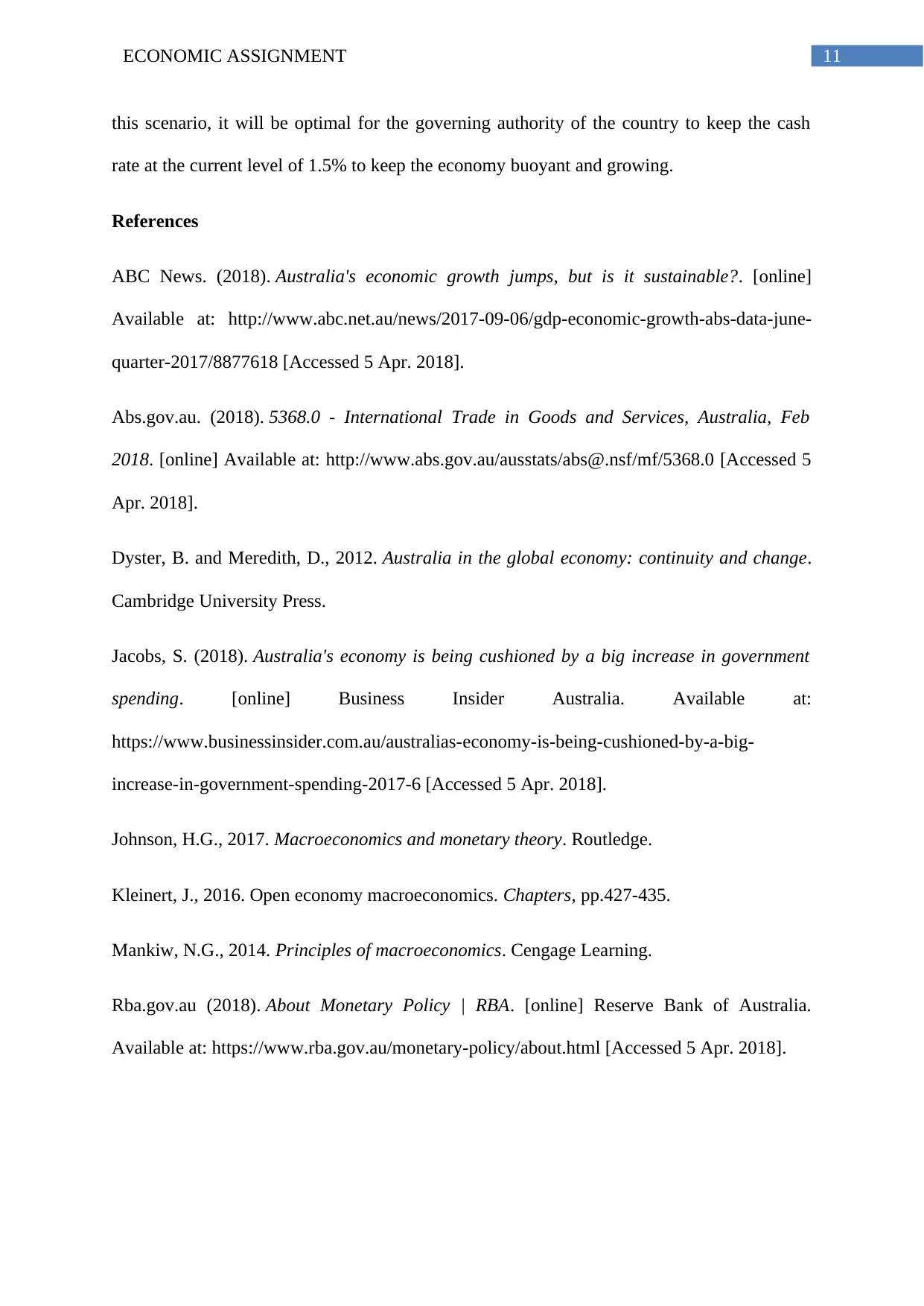
11ECONOMIC ASSIGNMENT
this scenario, it will be optimal for the governing authority of the country to keep the cash
rate at the current level of 1.5% to keep the economy buoyant and growing.
References
ABC News. (2018). Australia's economic growth jumps, but is it sustainable?. [online]
Available at: http://www.abc.net.au/news/2017-09-06/gdp-economic-growth-abs-data-june-
quarter-2017/8877618 [Accessed 5 Apr. 2018].
Abs.gov.au. (2018). 5368.0 - International Trade in Goods and Services, Australia, Feb
2018. [online] Available at: http://www.abs.gov.au/ausstats/abs@.nsf/mf/5368.0 [Accessed 5
Apr. 2018].
Dyster, B. and Meredith, D., 2012. Australia in the global economy: continuity and change.
Cambridge University Press.
Jacobs, S. (2018). Australia's economy is being cushioned by a big increase in government
spending. [online] Business Insider Australia. Available at:
https://www.businessinsider.com.au/australias-economy-is-being-cushioned-by-a-big-
increase-in-government-spending-2017-6 [Accessed 5 Apr. 2018].
Johnson, H.G., 2017. Macroeconomics and monetary theory. Routledge.
Kleinert, J., 2016. Open economy macroeconomics. Chapters, pp.427-435.
Mankiw, N.G., 2014. Principles of macroeconomics. Cengage Learning.
Rba.gov.au (2018). About Monetary Policy | RBA. [online] Reserve Bank of Australia.
Available at: https://www.rba.gov.au/monetary-policy/about.html [Accessed 5 Apr. 2018].
this scenario, it will be optimal for the governing authority of the country to keep the cash
rate at the current level of 1.5% to keep the economy buoyant and growing.
References
ABC News. (2018). Australia's economic growth jumps, but is it sustainable?. [online]
Available at: http://www.abc.net.au/news/2017-09-06/gdp-economic-growth-abs-data-june-
quarter-2017/8877618 [Accessed 5 Apr. 2018].
Abs.gov.au. (2018). 5368.0 - International Trade in Goods and Services, Australia, Feb
2018. [online] Available at: http://www.abs.gov.au/ausstats/abs@.nsf/mf/5368.0 [Accessed 5
Apr. 2018].
Dyster, B. and Meredith, D., 2012. Australia in the global economy: continuity and change.
Cambridge University Press.
Jacobs, S. (2018). Australia's economy is being cushioned by a big increase in government
spending. [online] Business Insider Australia. Available at:
https://www.businessinsider.com.au/australias-economy-is-being-cushioned-by-a-big-
increase-in-government-spending-2017-6 [Accessed 5 Apr. 2018].
Johnson, H.G., 2017. Macroeconomics and monetary theory. Routledge.
Kleinert, J., 2016. Open economy macroeconomics. Chapters, pp.427-435.
Mankiw, N.G., 2014. Principles of macroeconomics. Cengage Learning.
Rba.gov.au (2018). About Monetary Policy | RBA. [online] Reserve Bank of Australia.
Available at: https://www.rba.gov.au/monetary-policy/about.html [Accessed 5 Apr. 2018].
⊘ This is a preview!⊘
Do you want full access?
Subscribe today to unlock all pages.

Trusted by 1+ million students worldwide
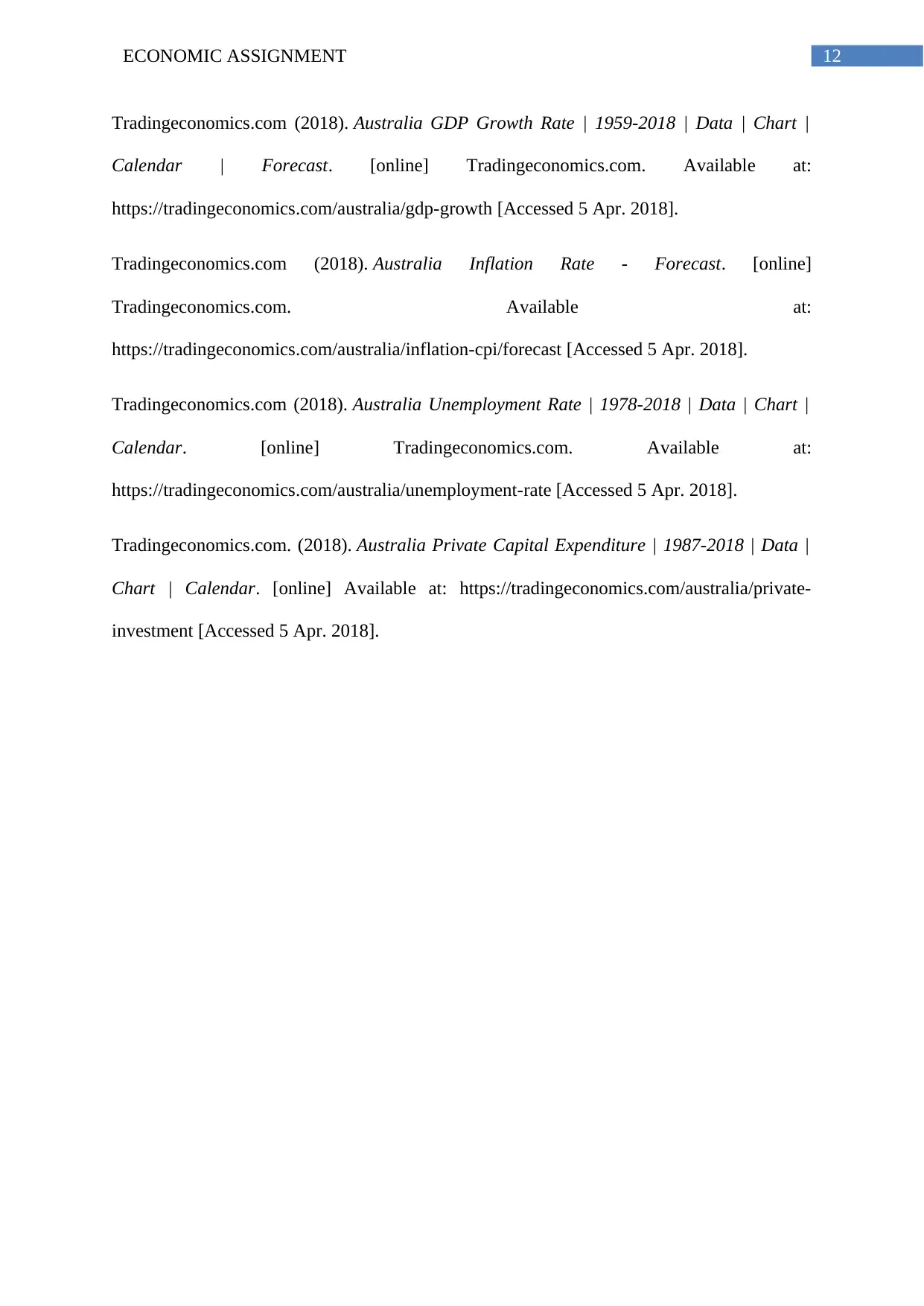
12ECONOMIC ASSIGNMENT
Tradingeconomics.com (2018). Australia GDP Growth Rate | 1959-2018 | Data | Chart |
Calendar | Forecast. [online] Tradingeconomics.com. Available at:
https://tradingeconomics.com/australia/gdp-growth [Accessed 5 Apr. 2018].
Tradingeconomics.com (2018). Australia Inflation Rate - Forecast. [online]
Tradingeconomics.com. Available at:
https://tradingeconomics.com/australia/inflation-cpi/forecast [Accessed 5 Apr. 2018].
Tradingeconomics.com (2018). Australia Unemployment Rate | 1978-2018 | Data | Chart |
Calendar. [online] Tradingeconomics.com. Available at:
https://tradingeconomics.com/australia/unemployment-rate [Accessed 5 Apr. 2018].
Tradingeconomics.com. (2018). Australia Private Capital Expenditure | 1987-2018 | Data |
Chart | Calendar. [online] Available at: https://tradingeconomics.com/australia/private-
investment [Accessed 5 Apr. 2018].
Tradingeconomics.com (2018). Australia GDP Growth Rate | 1959-2018 | Data | Chart |
Calendar | Forecast. [online] Tradingeconomics.com. Available at:
https://tradingeconomics.com/australia/gdp-growth [Accessed 5 Apr. 2018].
Tradingeconomics.com (2018). Australia Inflation Rate - Forecast. [online]
Tradingeconomics.com. Available at:
https://tradingeconomics.com/australia/inflation-cpi/forecast [Accessed 5 Apr. 2018].
Tradingeconomics.com (2018). Australia Unemployment Rate | 1978-2018 | Data | Chart |
Calendar. [online] Tradingeconomics.com. Available at:
https://tradingeconomics.com/australia/unemployment-rate [Accessed 5 Apr. 2018].
Tradingeconomics.com. (2018). Australia Private Capital Expenditure | 1987-2018 | Data |
Chart | Calendar. [online] Available at: https://tradingeconomics.com/australia/private-
investment [Accessed 5 Apr. 2018].
1 out of 13
Related Documents
Your All-in-One AI-Powered Toolkit for Academic Success.
+13062052269
info@desklib.com
Available 24*7 on WhatsApp / Email
![[object Object]](/_next/static/media/star-bottom.7253800d.svg)
Unlock your academic potential
© 2024 | Zucol Services PVT LTD | All rights reserved.





